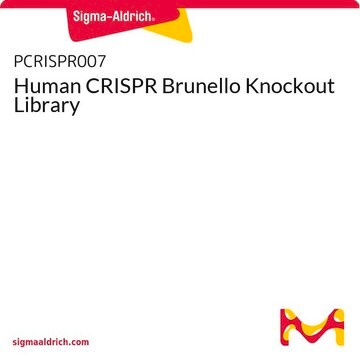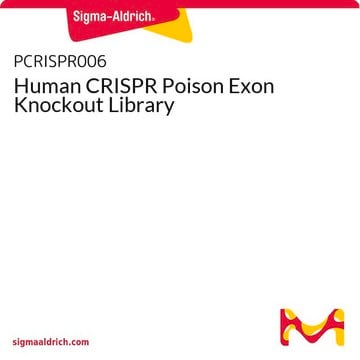SHPH2
MISSION® LentiPlex® Human Pooled shRNA Library TRC2
For Rapid, Convenient Genome-wide shRNA Screens
About This Item
Productos recomendados
product line
MISSION®
concentration
≥5x108 VP/ml (via p24 assay)
technique(s)
capture ELISA: 5 x 108 TU/mL using p24
shipped in
dry ice
storage temp.
−70°C
General description
The MISSION LentiPlex Human shRNA Pooled Library 2.0 includes additional gene and clone coverage from the previously offered LentiPlex 1.0 Pooled Library . With the addition of 2.0, which consists of 5,000+ human genes and 20,000+ total clone coverage divided into 3 subpools, the complete whole-genome human library complete whole-genome human librarynow consists of over 125,000 shRNA constructs from the TRC collection targeting 20,000+ human genes. Each library is tested for shRNA representation before product release to ensure robust library coverage. The complete library is provided in ready-to-use lentiviral format at titers of at least 5 x 108 TU/ml via p24 assay and is pre-divided into sixteen subpools of approximately 6,000-8,000 shRNA constructs each. Amplification and sequencing primers are also provided for downstream target identification.
For more information including sample data and uses, please visit our LentiPlex Technical Detail Page.
Other Notes
Amplification and sequencing primers are also provided for downstream hit identification.
Deconvolution of shRNA Pools
Sigma′s deconvolution service lets you easily identify the genes that impact your pooled shRNA screen.
- Next-generation sequencing of clonesgives a precise number of individual clone occurrence within a pooled shRNA sample
- Comprehensive, reproducible results from pooled shRNA screens
- Statistically robust and information-rich data
Contact your local Sigma sales representative for more information or submit an inquiry to MISSION RNAi
Recommended products
Legal Information
Storage Class
12 - Non Combustible Liquids
wgk_germany
WGK 3
flash_point_f
Not applicable
flash_point_c
Not applicable
Certificados de análisis (COA)
Busque Certificados de análisis (COA) introduciendo el número de lote del producto. Los números de lote se encuentran en la etiqueta del producto después de las palabras «Lot» o «Batch»
¿Ya tiene este producto?
Encuentre la documentación para los productos que ha comprado recientemente en la Biblioteca de documentos.
Artículos
RNAi Consortium (TRC): Collaborative effort among academic labs and biotech/pharma institutes advancing RNA interference research.
Contenido relacionado
El cribado satisfactorio para el descubrimiento de compuestos candidatos y dianas farmacológicas requiere reactivos y suministros de gran rendimiento, probados y adecuados para el proceso. Encuentre las herramientas adecuadas para sus procesos de CRO, farmacéuticos o biotecnológicos destinadas al cribado de moléculas pequeñas y productos biológicos, así como para sólidos análisis de inmunogenicidad destinados a garantizar la seguridad terapéutica.
High-throughput reagents for drug target screening and immunogenicity testing.
Nuestro equipo de científicos tiene experiencia en todas las áreas de investigación: Ciencias de la vida, Ciencia de los materiales, Síntesis química, Cromatografía, Analítica y muchas otras.
Póngase en contacto con el Servicio técnico








